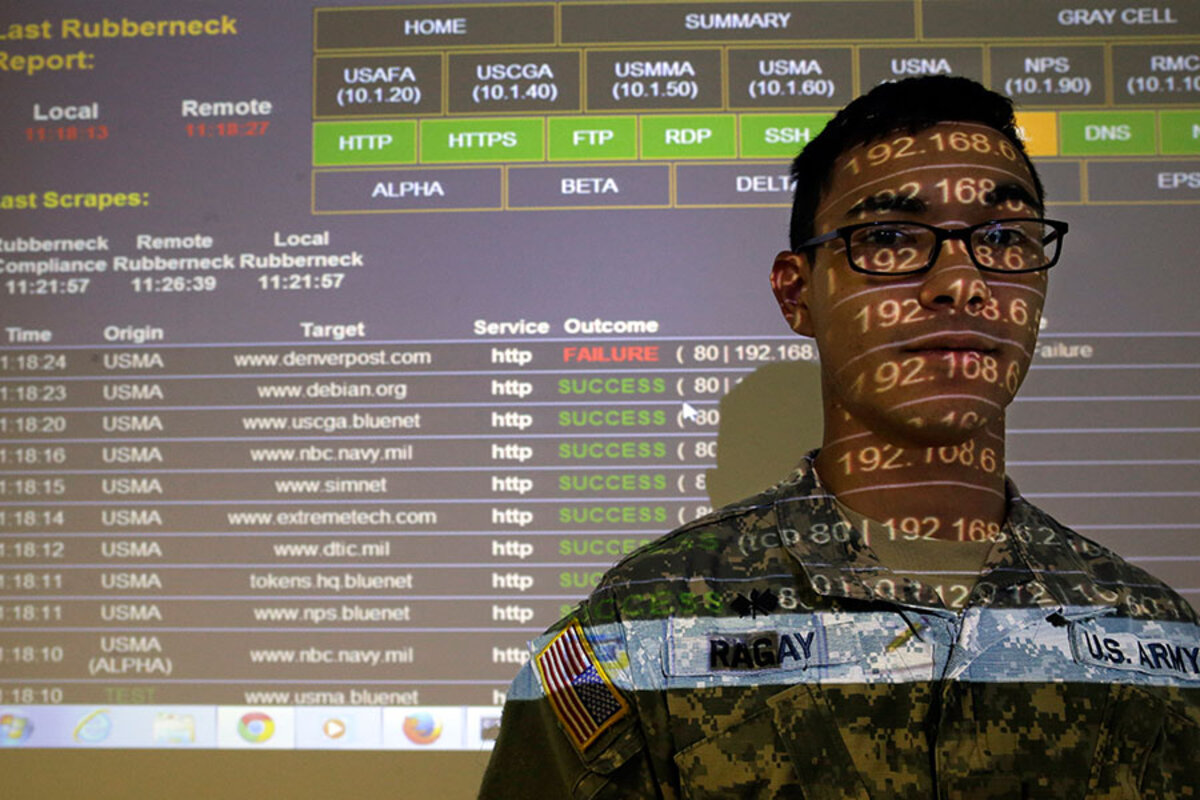Should America fight more like Iran? Pentagon official raises eyebrows.
Loading...
| Washington
The American military must become better at operating in a “gray zone” of war, one that sometimes calls for using “deception, infiltration, and persistent denial,” the Pentagon’s No. 2 official said in a little-noticed speech this week.
These are the sort of tactics that Russia has been using in Crimea and Ukraine, Deputy Defense Secretary Bob Work noted Wednesday in remarks at a strategy conference at the United States Army War College in Carlisle, Pa.
America’s adversaries today use “agents, paramilitaries, deception, infiltration, and persistent denial – staying within that so-called ‘gray zone,’ ” he told assembled officers. “That’s a zone in which we don’t typically operate, but one in which we must become more proficient.”
Is America’s second most senior civilian in the Pentagon suggesting that the country should … play dirty? Is Russia really a model for what the kind of military action the United States wants to take?
Perhaps not, say several military analysts. Rather, his comments point to the evolving nature of war and America's need to change with it.
For the foreseeable future, America’s wars will be fought in the gray zone, and it should seek to be as good in this realm as it is in conventional warfare. That means knowing how to use militias as deftly as Russia and Iran do, how to use social media propaganda as effectively as the Islamic State, as well as how to cope with improvised explosive devices and cyber attacks.
“The whole concept of 'asymmetric' warfare just means that someone is not being stupid,” says Paul Scharre, a fellow at the Center for a New American Security. “Why should you assume that our enemies won’t be smart?”
In his remarks at the War College, Work outlined the ways in which he believes this warfare is advancing, from asymmetric attacks to a blend of low and high-tech tactics known as hybrid warfare.
“If the streets of Baghdad and the valleys of Afghanistan were a laboratory of irregular war, I believe that what we will increasingly see in the future is hybrid wars,” he said.
The US caught a particular glimpse of this in the 2006 Lebanon War, when the Israeli Defense Forces (IDF) battled Hezbollah.
“Hezbollah had gone to school on the IDF, transforming from a guerrilla force to a formidable quasi-conventional fighting force that was able to fight the IDF to a standstill.”
The “next level up,” says Work, is what the US military has observed in Crimea and Ukraine. “In both places, the Russians have unleashed what their chief of the general staff called ‘non-linear warfare.’ ”
It resembles “Hezbollah on steroids” and in it, Work added, “I really believe we’re seeing a laboratory of future 21st century land warfare.”
The battles in Crimea and Ukraine, for example, have included everything from “covert action by special operations forces to sustained unconventional warfare waged under an umbrella of denial, then ultimately escalating to force-on-force proxy combat,” he said.
“It’s when this type of conflict moves from the shadowy actions of ‘fifth columns’ and ‘little green men’ to force-on-force conflict that it will prove the most challenging.”
Is Work advocating that the US military respond in kind? Mr. Scharre doesn’t see it this way.
“Just because Russia’s doing something, that doesn’t mean we want to do the same thing they’re doing.”
But the Pentagon needs “to be aware of those things, and not treat them as unimportant.”
And while the US may not necessarily need to respond in kind, it will want to respond.
This might include, for example, strengthening the US military’s ability to respond to proxies and hardening the systems of the US and its allies against cyberattacks, says Scharre, who served as a Special Operations reconnaissance team leader in Iraq and Afghanistan, and later worked in the Office of the Secretary of Defense from 2008 to 2013 helping to develop emerging weapons technologies.
“I don’t see anything alarming in the speech – it’s more a call to open our eyes to what’s happening,” he adds. “We need to be more flexible.”
This flexibility might mean using proxies, says Andrew Krepinevich, president of the Center for Strategic and Budgetary Assessments. The US military has done it before, and may need to do it again, he adds.
Just as US adversaries including Iran “are using Hezbollah and the Mahdi Army, we may have to look for opportunities, especially if we want to keep a small footprint,” says Dr. Krepinevich, who served in the Army for 21 years and also worked in the Office of Net Assessment, the Pentagon’s internal think tank.
The US military can enable resistance groups to wage hybrid warfare against its own enemies, too, he adds. One of the trickiest dangers in this, however, is empowering the wrong people.
“There’s a presumption that your interests are the same as those you’re supporting.” Yet less than four years after US forces left Vietnam, China was invading. “Their [North Vietnamese] clients that were waging war against us became adversaries.”
And of course some of the Mujahideen fighters that the Pentagon supported during the Soviet War in Afghanistan went on to form the seeds for Al Qaeda.
“Even though you may have a common interest in defeating a common enemy, you have to realize that you and the group you’re sponsoring and giving the capabilities to wage hybrid warfare may have common interests that are enduring once that particular obstacle is removed,” Krepinevich says.
“Once the Soviets left Afghanistan, we and the Mujahideen turned out to have very different long-term interests.”
In these situations, it is helpful to provide resources to proxies that “can be turned off” once the conflict is over.
The shoulder-fired stinger anti-aircraft missiles “is a capability you can turn off fairly quickly” since once the missiles are gone, the launcher is useless, Krepinevich says.
On the other hand, tanks and combat aircraft can last a lot longer. “The Iranians were still flying F-14s long after the Shah had been deposed.”





